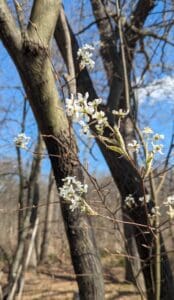By Jennifer Fairfield
Are you as tired of the dreary gray days as I am?
Don’t get me wrong – I’m not complaining that we haven’t had the bitter cold and huge amounts of snow that January typically brings, but a little sun wouldn’t hurt every now and then, would it? And we really could use a proper freezing for a little bit – it’s necessary for some of our plants, and to help kill off diseases and pests. I’m not looking for any of that below zero stuff with three feet of snow, mind you. Just a number of days with the temperatures below freezing – but not too far below! Am I asking for too much?
Things to do outdoor this month:
If you sometimes have deer or rabbit damage, it would not be a bad idea to treat your vulnerable plants with a repellant, or re-treat if you treated earlier. Food options are slim for these guys at this time of year, so they will be looking for easy pickings, and that might be your landscaping plants.
Some of the weather forecasters are saying we might actually see some lower temperatures later this month, which can be both a good thing and a bad thing – good, as I mentioned above, because it can help kill off diseases and pests, but bad because it makes it hard for evergreens to take up water from the soil. An anti-desiccant spray on your evergreens early this month can help to prevent winter burn.
Be sure to check the instructions to make sure you are using them properly and at the right time.
Also consider spraying your trees with dormant oil when the temperatures are a little higher than normal, but while trees are still dormant. Dormant oils are used to control a variety of insects, generally by suffocating them. Again, read directions carefully to make sure that you are using the oil meant for your plant and that you are using it at the right time.
Late this month (or early in March), while trees and shrubs are still dormant and growth has not yet begun, is also the best time to prune most of them. Pruning at this time of year is generally done to encourage lots of new growth in the spring. Pruning can also be done to remove dead or damaged branches, to create better growing conditions for other plants in your landscape, or to make mowing or walking around your trees or shrubs easier.
It’s especially important to prune oak trees in late winter. Pruning oak trees at any other time of year can lead to oak wilt disease, which is generally fatal to oaks.
To ensure that you see the most blossoms possible this spring on your early-blooming trees and shrubs, don’t prune them until after they have bloomed. This includes such plants as forsythia, lilacs, azaleas, and dogwoods, which bloom on last year’s growth
Keep feeding the birds and providing them with fresh water.
Indoor:
If you didn’t do it in the fall, now is the time for cleaning and sharpening your tools so that they are ready for the season, when it comes.
Seeds will be coming into The Garden Mill over the next couple of weeks (one of my favorite things about this time of year). Though March and April are the time to start most plants from seed for your vegetable garden, start Rosemary in early February. It’s very slow to germinate and get growing, so you need to give it lots of time and have lots of patience with it.
Toward the end of the month, start parsley, leeks, and onions (if you are starting them from seed, as opposed to planting sets).
Starting perennials from seed can be an inexpensive way to get a lot of plants. Starting them early indoor gives them more time to get to transplanting size, and you have more chance of getting blooms the first year by starting them now.
One more task to complete this month indoor is cleaning out any pots you might be planning to use for repotting of house plants or for outdoor container gardening this spring and summer. It’s a really good idea to disinfect your pots before using them again, to be sure they are not harboring any bacteria that could harm or even kill your plants.
I like to do this task now so the pots will be ready for me to use when I’m ready for them. That way, I’m not tempted to skip this important step because I’m in a hurry to get to work – or just so excited to be planting something.
I use a 1 to 9 ratio of bleach to water and a wire brush to be sure to get all the leftover dirt, and then thoroughly rinse the pots to be sure to get rid of the bleach.
Happy Gardening.














